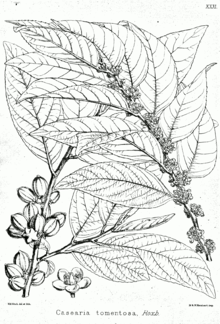Casearia
 From Wikipedia - Reading time: 5 min
From Wikipedia - Reading time: 5 min
| Casearia | |
|---|---|

| |
| Casearia tomentosa parts drawing | |
| Scientific classification | |
| Kingdom: | Plantae |
| Clade: | Tracheophytes |
| Clade: | Angiosperms |
| Clade: | Eudicots |
| Clade: | Rosids |
| Order: | Malpighiales |
| Family: | Salicaceae |
| Subfamily: | Samydoideae |
| Genus: | Casearia Jacq.[1] |
| Species | |
|
Numerous, see text | |
| Synonyms | |
| |
Casearia is a plant genus in the family Salicaceae. The genus was included in the Flacourtiaceae under the Cronquist system of angiosperm classification, and earlier in the Samydaceae.
They are sometimes employed as honey plants, notably C. decandra and C. sylvestris. The latter species is occasionally used as food by the caterpillars of the two-barred flasher (Astraptes fulgerator). Several species are becoming rare due to deforestation. Some appear close to extinction, and C. quinduensis of Colombia and C. tinifolia from Mauritius seem to be extinct since some time in the 20th century and about 1976, respectively.
Selected species
[edit]- Names brought to synonymy
- Casearia elegans Standley, a synonym for Casearia bartlettii
References
[edit]- ^ "Genus: Casearia Jacq". Germplasm Resources Information Network. United States Department of Agriculture. 2006-03-31. Archived from the original on 2012-10-09. Retrieved 2010-11-18.
- ^ a b "GRIN Species Records of Casearia". Germplasm Resources Information Network. United States Department of Agriculture. Archived from the original on 2015-09-24. Retrieved 2010-11-18.
External links
[edit]![]() Media related to Casearia at Wikimedia Commons
Media related to Casearia at Wikimedia Commons
![]() Data related to Casearia at Wikispecies
Data related to Casearia at Wikispecies
Licensed under CC BY-SA 3.0 | Source: https://en.wikipedia.org/wiki/Casearia6 views | Status: cached on November 27 2024 17:48:53↧ Download as ZWI file
 KSF
KSF